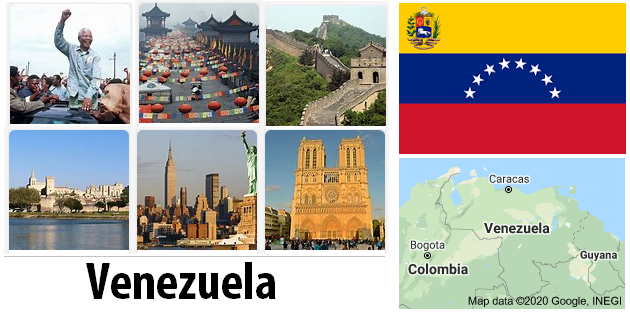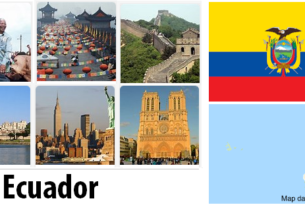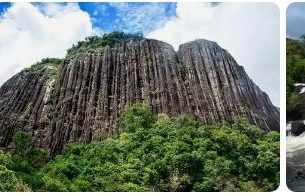The “Tierra firme” (mainland), that is the Venezuelan continental area, was discovered by Christopher Columbus in 1498. The following year it was explored by Ojeda and the Florentine Amerigo Vespucci, who disembarking on the coast of the Maracaibo lagoon, discovered a village indigenous built on stilts and, in memory of the Venetian lagoon city, it gave it the name of “Pequena Venecia”, that is “Venezietta”, or “Venezuela”, and the latter then extended to all the mainland.
In 1527 Juan de Ampuz founded Santa Ana de Coro, but Charles V, king of Spain, granted this territory as a fiefdom for twenty years to the Germans Welser, great bankers of Augusta.
In 1547 Juan Perez restored the authority of the Spanish crown and the first cities were founded, including Caracas (1567).
In the seventeenth century G. David Nau, called the “Olonnese”, French buccaneer, led countless expeditions against the Spaniards to America, and destroyed Maracaibo.
In the 18th century, the colony grew in value for the trade and cultivation of cocoa, stimulated by the “Guipuzcoana Company” of Caracas (1728/1765 Guipuzcoa is a Basque province, the smallest in Spain).
Erected in the Capitaneria Generale in 1777, seat of the Judicial Court in 1786, Venezuela, after unsuccessful attempts (1797/1806), rose against the Spaniards and on July 5, 1811 a Congress proclaimed independence. The head of the revolution was Francisco Miranda, assisted by Simon Bolivar.
In 1812 Spain attempted to rearrange it, but Bolivar rejected the attackers and Venezuela joined the Republic of Granata, forming Grande Colombia. Due to Panama’s failure to vote, this union dissolved in 1830.
In Venezuela there followed governments, now reactionary, now liberal, with conflicts and civil strife.
General Antonio Guzman Blanco, from 1870 to 1888, knew how to give twenty years of peace and well-being to the country which then had a long period of internal troubles and a long conflict with Great Britain, for the borders of Guyana (1895 / 96), with Germany and with Italy and Great Britain for insults to their respective subjects (1902) and with the United States and Holland for the same reason.
In 1909 J. Vincente Gomez established a dictatorship that lasted until 1935, and which ensured Venezuela a long period of tranquility and economic prosperity, also due to the discovery, made in 1918, of some oil fields.
In the 1st World War, Venezuela remained neutral.
In 1936, after Gomez’s death, the Constitution was modified and General Eleazar Lopez Contreras was elected president, who was later reconfirmed for twenty years.
He in 1938 presented a three-year plan for the improvement of agricultural production and emigration, intensified public works, commissioned a Dutch company for major renovations of the port of La Guayra; he intensified public works and planned the urban reorganization of the city of Caracas, the capital.
But in 1939 a great fire occurred near Maracaibo which destroyed the center of Lagunillas; there was a serious drop in exports, there was a restriction on imports, the devaluation of the “bolivar” and the deleterious consequences of the war meant that the economic situation became as serious as the political one. The disaster was partially remedied through trade agreements with the United States and the doubling of coffee quotas. As Lopez refused to be re-elected at the end of his mandate, on 9 May 1941 he was succeeded by General Isaias Medina Angarita, who, as a good democrat, authorized his rival, the novelist Romolo Gallegos, to found the party that was called “Accion Democratica”.
On December 31, 1941, he broke diplomatic ties with the Axis. He concluded numerous commercial agreements, renewed the civil code and instituted income tax. Since in 1943 his majority in government was renewed, he granted three portfolios to liberals; embarked on a trip to the United States to improve trade relations so that natural resources could be best exploited in the country; supplied raw materials to the United States and these made available coast defense aid; he fought strenuously against illiteracy, liquidated some German and Japanese firms, proclaimed the law for social assistance and, finally, dissolved the communist leagues.
In 1945, however, he recognized the legality of that party, but in October of the same year, due to a revolution, which among other things declared the state of siege, he was forced to repair in the United States and with him Lopez and some others government officials.
The new president, the socialist Romulo A. Betancourt, soon recognized internationally, reassured the oil companies; in March 1946 he lifted the state of siege and granted freedom to political prisoners. New upheavals, however, occurred for the struggles between conservatives, communists and “Accion Democratica” and after various alternations there were elections in December 14, 1947 which led to the presidency Romulo Gallegos, contested by the conservatives, but with the help of the army.
On November 20, 1948, the government again decreed the state of siege and this resulted in a coup. Gallegos went into exile in Cuba and power passed into the hands of a military junta chaired by Lieutenant Colonel Carlos Delgado Chalbaud who dissolved Parliament. He was a despot, suspended all civil liberties, suppressed all opposition parties and imprisoned their leaders.
On November 13, 1950 he was assassinated.
The government was temporarily taken over by German Suarez Flamerich who called the elections for November 30th.
The center-left Democratic Republican Union was the most suitable for the victory but due to rigging the elections were invalidated and the government passed into the hands of Colonel Marcos Perez Gimenez. See Countryaah for population and country facts about Venezuela.
On April 15, 1953 a new Constitution was approved and Gimenez was in charge for 5 years, and he transformed it into a dictatorship.
But in the meantime, due to the well-known crisis of Iran in 1951 and the issue of the Suez Canal in 1956, the Venezuelan oil production had multiplied and, of course, also the export. Thus the economic situation of the country completely changed and became one of the most prosperous in the world.
Gimenez had massive public works carried out, especially in the capital, and had two Italian companies set up a steel mill sufficient to meet all the needs of the country. But all this, while it brought about a great change in the economy of the citizens concerned in the various sectors, did not bring any advantage to the large mass of workers, especially the agricultural ones. For this reason, Gimenez, who had managed to be reconfirmed by a plebiscite on January 1, 1958, was overthrown by a popular uprising and replaced by a “Patriotic Junta”, headed by Admiral Wolfang Larrazabal.


